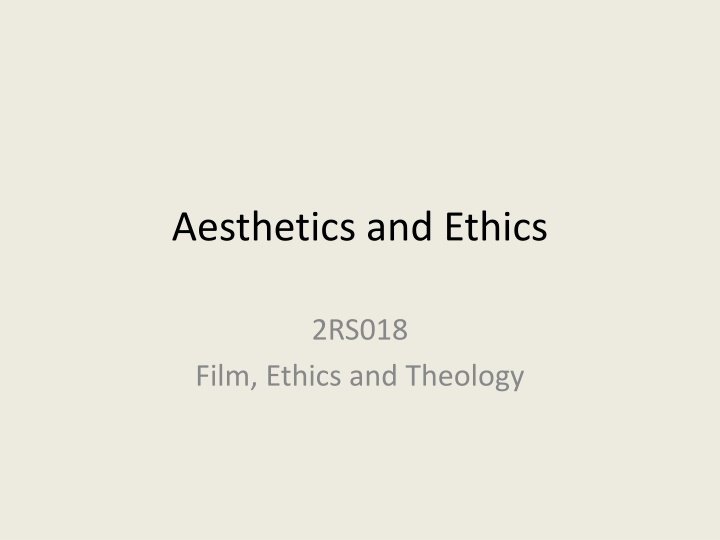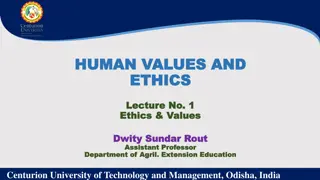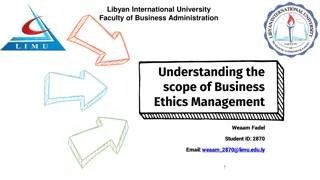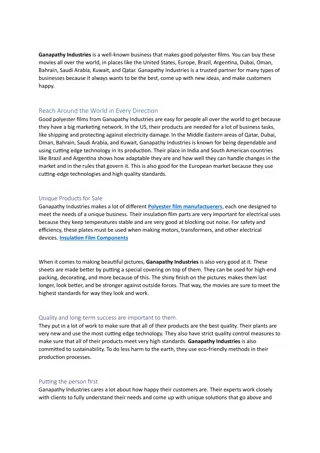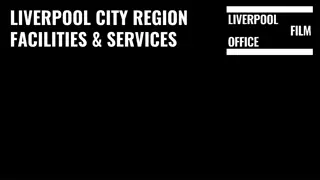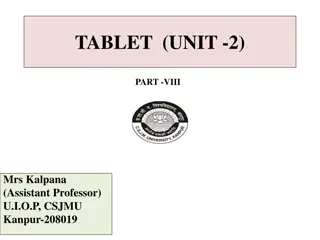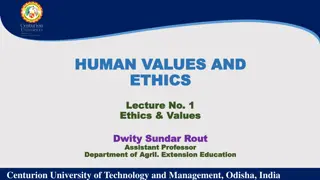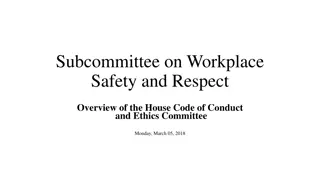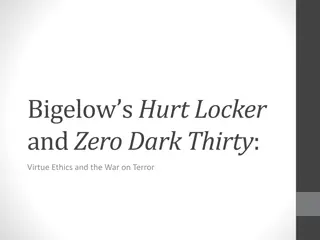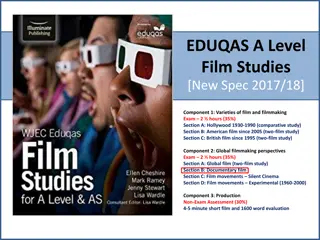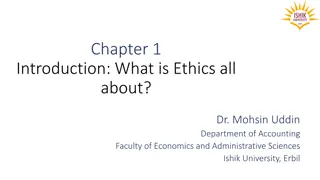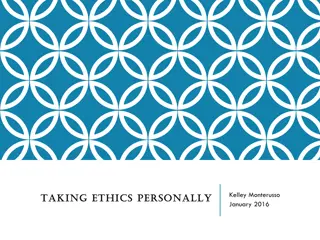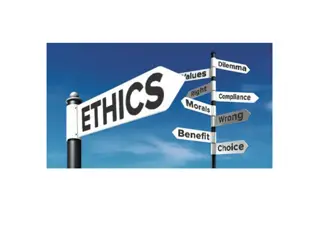Film Ethics and Ideology Analysis
Explore the intersection of film ethics and ideology, examining historical links in film studies, portrayal of morally charged situations, and the ethical implications of film production and audience reception. Delve into Karl Marx's critique of religion and ideology as applied to film as a symptom of societal norms and values.
Download Presentation

Please find below an Image/Link to download the presentation.
The content on the website is provided AS IS for your information and personal use only. It may not be sold, licensed, or shared on other websites without obtaining consent from the author.If you encounter any issues during the download, it is possible that the publisher has removed the file from their server.
You are allowed to download the files provided on this website for personal or commercial use, subject to the condition that they are used lawfully. All files are the property of their respective owners.
The content on the website is provided AS IS for your information and personal use only. It may not be sold, licensed, or shared on other websites without obtaining consent from the author.
E N D
Presentation Transcript
Aesthetics and Ethics 2RS018 Film, Ethics and Theology
Ethics in film studies Robert Sinnerbrink notes that three links between film and ethics have been historically common in film studies (2016: 10): Ethics in film (portrayal of morally charged situations, conflicts, decisions, etc.) The ethics of film: film production; audience reception Film as symptom of ethical condition
Ethics in film Portrayal of ethics, in the film world, e.g.: situations; temptation/dilemma; moral corruption /regeneration; displays of virtues/character;
Ethics of film Ethics of film in real- world , e.g.: experience of actors; environmental impact of production; effect of films upon behaviour;
Film as symptom (ideology) This approach can be traced back to Karl Marx s critique of religion and ideology 1. Religion arises out of real need alienated labour; poverty; dispossession, etc. 2. Religion misconstrues that need sin ; fallenness ; salvation ; heaven , etc. 3. Religious subjects relate to their real needs via these misconstructions repentance; faith; obedience; perseverance, etc. the religious distortion of the real world feeds back into the very social relationships from which it arises. It is thus true that through religion, social agents really live out their social relationships in distorted form, so that the false world of religion is this world lived out in false form. (Turner in Carver 1991)
Film as symptom (ideology) But for Marx, ideology is not just about religion, but all sorts of ideas: The production of notions, ideas and consciousness is from the beginning directly interwoven with the material activity and the material intercourse of human beings, the language of real life. The production of men's ideas, thinking, their spiritual intercourse, here appear as the direct efflux of their material condition. The same applies to spiritual production as represented in the language of politics, laws, morals, religion, metaphysics, etc. of a people. (Marx in Bocock and Thompson 1985: 12)
Film as symptom (ideology) During the 20thcentury, this approach was applied to popular culture, and used to analyse cultural products like film Films express visions of life, normality, and contain ideals and even messages about how to live; in this sense, on a Marxist account, films might serve a similar ideological purpose. E.g. https://www.youtube.com/watch?v=1pUXH1Bye88 &ab_channel=AvengedS939- TheJamesBondNetwork
Ethics and film experience However, more recent scholars have suggested that these approaches do not convey what might be ethically significant about the experience of watching film this experience is first of all an aesthetic experience so does this mean that we need to think about how to relate ethics and aesthetics?
Ethics and film experience Sinnerbrink argues that we need to explore this aesthetic experience, if we are to understand the ethical significance of film: To these three dimensions we can add a fourth: the aesthetic dimension of cinema in particular the role of aesthetic form in intensifying our experience, refining and focusing our attention, and thus of conveying complexity of meaning through manifold means as a way of evoking ethical experience and thereby inviting further ethical-critical reflection. (2016: 16)
2RS018 Film, Ethics and Theology BEAUTY AND GOODNESS
Beauty and goodness What does beauty have to do with goodness? There are a number of different questions that we might ask. One is about how beauty and goodness are conceptually connected: is there an analytic connection between the notions of the aesthetic and the ethical? There is a long tradition of supposing that the two are intimately intertwined. For instance, it has often been argued that moral virtues are beauties, sometimes in the sense that moral virtues possess beauty, sometimes in the stronger sense that moral virtues are identical with a kind of beauty, beauty of the soul. (Gaut 2007: 7
Beauty and goodness And a connected issue is about the relationship between aesthetic and moral value: A fourth issue concerns whether there is an intrinsic relation between art and morality. Is it the case that the ethical goodness of the attitudes, if any, manifested in a work of art contributes towards its aesthetic value? This question is distinct from the causal issue; for that question is one about the moral causal effects of (some) art on its actual audience: as such, its answer must draw on empirical psychological and sociological investigations. The intrinsic question, in contrast, is not about the effects of art, but about an internal relation of the aesthetic to the moral domains: does the moral value of works condition their aesthetic value? (Gaut 2007: 8)
Beauty and goodness And we might also note the idea of aesthetic value and moral goodness both raise similar questions, about metaphysics, objectivity, etc.: [another] issue that has figured in the long debate concerns whether there is a structural symmetry between the moral and the aesthetic domains. The structural symmetry view holds that fundamental aspects of aesthetic and moral values are the same: for instance, that realism (or irrealism) is the correct account of both sorts of value, or that both kinds of value are expressible in terms of principles (or that neither are), or that both kinds of value are objective (or subjective), or universal (or relative), and so forth. (Gaut 2007: 8)
Beauty and goodness Very roughly, we can distinguish three approaches to these kinds of issues: 1. Autonomism: the position that aesthetic and artistic values are entirely separate from moral value. Critics and appreciators should never concern themselves with moral values when evaluating works of art (E.g. Oscar Wilde). 2. Moralism: the position that works of art in possession of moral value are at least sometimes more valuable because of their moral value (or vice- versa). Critics and appreciators should therefore at least sometimes concern themselves with moral values when evaluating works of art (E.g. David Hume, Berys Gaut). 3. Immoralism: the position that at least sometimes, a work s possessing a moral flaw makes a it more valuable as a work of art. Critics and appreciators should therefore at least sometimes concern themselves with moral values when evaluating works of art (E.g. A.W. Eaton).
Autonomism There is no such thing as a moral or an immoral book. Books are well written, or badly written. That is all. (Oscar Wilde, The Picture of Dorian Gray) This Photo by Unknown Author is licensed under CC BY-SA
Moralism The want of humanity and of decency, so conspicuous in characters drawn by several of the ancient poets [ ] diminishes considerably the merit of their noble performances [ ] We are not interested in the fortunes and sentiments of such rough heroes; we are displeased to find the limits of vice and virtue so much confounded (Hume 1993: 152).
Moralism I construe intrinsic ethical value in terms of the ethical features of the attitudes that the artwork manifests. The notion of an attitude should be understood broadly here, to cover not just characteristically affective states, such as showing disgust towards or approval of the characters, but also to cover more purely cognitive states, such as presenting characters in such a way as to imply judgements about their being evil, good, inspiring and so on. Thus in assessing the ethical value of art we are assessing the ethical quality of the point of view, cognitive and affective, that it takes towards certain situations. (Gaut 2007: 9)
The value of some works consists in the way they overcome our imaginative resistance to the immorality of a central character. So moral judgement is necessary to recognise the artistic value of the work: In cases [. . .] such as The Sopranos, the audience who found no moral fault with him would also fail to get the work because [ ] it would be too easy for such an audience to like the rough hero. (Eaton 2012: 284) Immoralism
For discussion 1. Does it make sense to evaluate a film on moral grounds? 2. Could an (aesthetically) good film be a (morally) bad film? 3. Can you think of any films that could be described as having a strong ethical vision ? How did you feel about this vision?
References BOCOCK, R., & THOMPSON, K. (1985). Religion and Ideology: A Reader. Manchester, UK, Manchester University Press in association with the Open University. GILLETT, P. (2013). Film and Morality. Newcastle upon Tyne, Cambridge Scholars. DEVEREAUX, M. (2010). Beauty and Evil: The Case of Leni Riefenstahl s Triumph of the Will in Aesthetics and Ethics: Essays at the Intersection, ed. J. Levinson. Cambridge, Cambridge Univ. Press. EATON, A.W. Robust Immoralism , The Journal of Aesthetics and Art Criticism 70 (2012), pp. 281-292. GAUT, B. Art, Emotion and Ethics, Oxford: Oxford University Press, 2007. HUME, D. Of the Standard of Taste in Hume: Selected Essays, Stephen Copley and Andrew Edgar, eds. Oxford: Oxford University Press, 1993. SINNERBRINK, R. (2016). Cinematic ethics: Exploring Ethical Experience through Film. Abingdon, Routledge STADLER, J. (2012). Pulling focus: Intersubjective Experience, Narrative Film, and Ethics. WILDE, O. The Picture of Dorian Gray, Ontario: Broadview Literary Texts, 2002.
